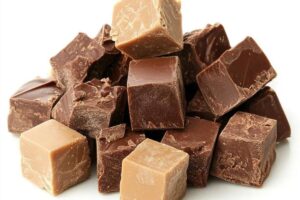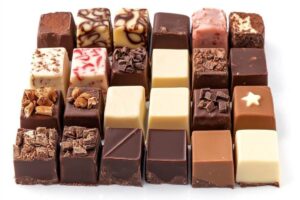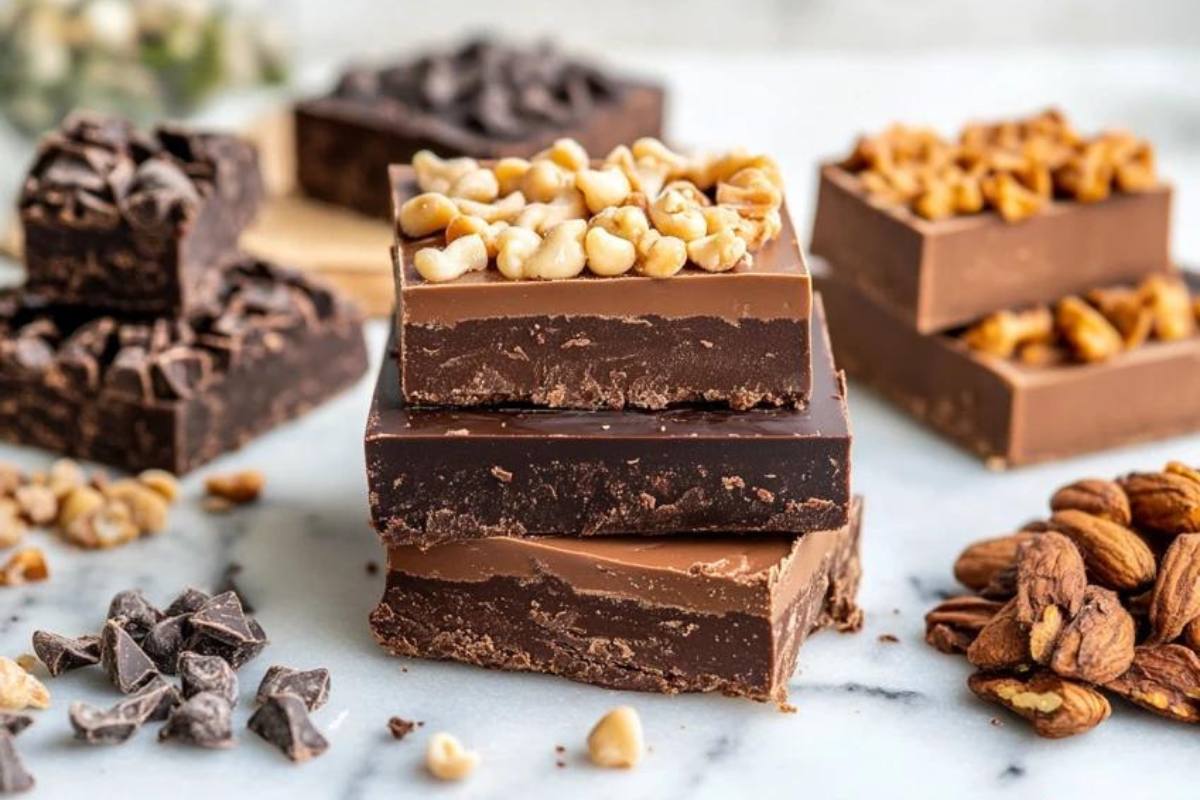Fudge and chocolate fudge are two beloved confections that have sweetened dessert lovers’ lives for generations. While they may seem similar at first glance, these two sweets have different ingredients, textures, and even methods of preparation that set them apart. Whether you’re an avid baker or simply a fan of sweet treats, understanding the distinction between fudge and chocolate fudge can help you appreciate their unique qualities.
What is Fudge?
Fudge is a type of confectionery made primarily from sugar, butter, and milk or cream. This sweet treat is typically heated to a specific temperature, allowed to cool slightly, and then beaten until it reaches a smooth, creamy texture. The origins of fudge are somewhat debated, but it’s commonly believed that it was created in the United States in the late 19th century, possibly as a result of a cooking error. You can dive deeper into the history of fudge for more interesting facts about its accidental invention and rise in popularity.
Unlike other types of candies, such as caramel or toffee, fudge has a softer texture that melts in your mouth. Traditionally, fudge was made with simple flavors like vanilla and maple, but over time, people have experimented with various ingredients to create a wide array of fudge flavors, such as peanut butter and fruit-infused fudge.
What is Chocolate ?
Chocolate fudge is, as the name implies, a variation of fudge that incorporates chocolate as a primary ingredient. While fudge can be made with a variety of flavors, chocolate fudge specifically uses cocoa powder or melted chocolate to add richness and depth to the final product. It’s one of the most popular types of fudge, beloved by chocolate enthusiasts for its dense, chocolaty texture and flavor.
The process for making chocolate fudge follows a similar method to regular fudge, with a few key differences. If you’re curious about how chocolate is made and its role in various confections, take a look at this informative guide on how chocolate is made.
Key Differences Between Fudge and Chocolate

While both fudge and chocolate fudge share the same basic cooking techniques, there are notable differences in their ingredients, texture, and flavor profiles.
- Ingredients: Traditional fudge is typically made with sugar, butter, and milk or cream. It can be flavored with extracts like vanilla or more exotic ingredients like fruit or nuts. On the other hand, chocolate fudge includes either cocoa powder or melted chocolate, giving it a rich and intense flavor.
- Texture: Regular fudge tends to have a softer and creamier texture, while chocolate fudge is denser due to the chocolate content, which makes it slightly firmer when set.
- Flavor: The flavor of fudge can vary widely depending on the added extracts or ingredients, but it generally has a buttery sweetness. Chocolate fudge, by contrast, has a much more robust, chocolaty taste that’s less sweet but more indulgent.
Ingredients Breakdown: Fudge vs. Chocolate
Traditional Fudge Ingredients:
- Sugar: The foundation of any fudge recipe, sugar is essential for both sweetness and structure.
- Butter: Adds richness and a smooth mouthfeel to the fudge.
- Milk or Cream: Provides moisture and helps to create a creamy texture.
- Flavorings: Popular choices include vanilla extract, maple syrup, or even fruit or nuts for added complexity.
Chocolate Fudge Ingredients:
- Sugar: Just like regular fudge, sugar is a critical component for sweetness and consistency.
- Butter: Used to add richness and smoothness to the fudge.
- Milk or Cream: Provides a smooth, creamy base.
- Cocoa Powder or Melted Chocolate: This is the defining ingredient that gives chocolate fudge its distinctive flavor and denser texture.
Texture Comparison: Creamy vs. Dense
The texture of fudge and chocolate fudge can be quite different, depending on the method of preparation and ingredients used.
- Regular Fudge: The texture is typically soft, smooth, and creamy, with a slight crumbly quality that melts in your mouth.
- Chocolate: Because of the added chocolate, chocolate has a denser texture, often with a firmer consistency that holds its shape better than traditional fudge.
This difference in texture can be attributed to the presence of cocoa or melted chocolate, which makes the fudge denser and richer.
Flavor Profile: Sweet Butter vs. Rich Chocolate
- Fudge: The flavor of regular fudge depends heavily on the ingredients used. In its simplest form, it has a sweet, buttery flavor that can be enhanced with extracts like vanilla or maple. Some recipes add nuts or fruit to create variations in flavor and texture.
- Chocolate: The defining characteristic of chocolate is its deep, rich chocolate flavor. It’s less sweet than traditional fudge but packs a more intense, decadent taste.
Cooking and Preparation Methods: Regular Fudge vs. Chocolate

Both fudge and chocolate are cooked in similar ways, but the introduction of chocolate changes the dynamics slightly.
Basic Cooking Method for Fudge:
- Ingredients:
- 2 cups granulated sugar
- ½ cup milk (or heavy cream for richer fudge)
- ½ cup butter (unsalted)
- 1 teaspoon vanilla extract
- 1 ½ cups chocolate chips (or any flavoring like peanut butter, etc.)
- Pinch of salt (optional)
Instructions:
- Prepare your equipment:
- Line an 8×8 inch (20×20 cm) pan with parchment paper or grease it lightly with butter.
- Have a candy thermometer ready, if using one, and a spoon for stirring.
- Combine ingredients:
- In a medium saucepan, combine the sugar, milk, and butter.
- If you want, add a pinch of salt for enhanced flavor.
- Cook the mixture:
- Place the saucepan over medium heat and stir constantly until the sugar dissolves and the mixture comes to a boil.
- Once it begins to boil, stop stirring and let the mixture cook. Use a candy thermometer if you have one, and cook until the mixture reaches the soft-ball stage (around 234°F or 112°C).
- If you don’t have a thermometer, you can test for the soft-ball stage by dropping a small amount of the mixture into cold water—it should form a soft, pliable ball.
- Remove from heat and add flavoring:
- Once it reaches the desired temperature, remove from heat and immediately stir in the vanilla extract and chocolate chips (or any other flavorings). Stir quickly until the mixture becomes thick and starts to lose its gloss.
- Pour into the pan:
- Immediately pour the mixture into the prepared pan and spread it evenly using a spatula.
- Cool and set:
- Allow the fudge to cool at room temperature for a few hours or refrigerate it until fully set.
- Cut and serve:
- Once the fudge is firm, cut it into small squares and enjoy!
Tips:
- Stirring while boiling can cause the fudge to crystallize and become grainy, so avoid stirring after the mixture starts boiling.
- For extra smooth fudge, use heavy cream instead of milk.
Cooking Method for Chocolate :
- Similar to the traditional fudge recipe, but cocoa powder or melted chocolate is added either during or after the heating process.
- Once the mixture reaches the soft-ball stage, it’s removed from the heat and beaten until smooth.
- The fudge is then poured into a pan and allowed to cool and set.
Because of the addition of chocolate, chocolate fudge can take a bit longer to set and is generally firmer once it cools.
Nutritional Differences Between Fudge and Chocolate
When it comes to nutrition, both fudge and chocolate are indulgent treats, but they do have some differences in terms of calorie and fat content.
| Nutritional Content | Traditional Fudge (per serving) | Chocolate Fudge (per serving) |
|---|---|---|
| Calories | 140 kcal | 180 kcal |
| Sugar | 18g | 21g |
| Fat | 5g | 8g |
| Protein | 1g | 2g |
| Carbohydrates | 22g | 25g |
Because of the added chocolate or cocoa butter, chocolate fudge tends to be higher in both calories and fat than traditional fudge. This difference makes chocolate fudge a more indulgent option, while regular fudge is slightly lighter (but still very rich!).
Common Misconceptions About Fudge and Chocolate
Many people mistakenly believe that chocolate is simply fudge with a dash of chocolate added. However, the truth is that adding chocolate fundamentally changes the way the fudge sets, its texture, and its overall flavor profile. Some other misconceptions include:
- Misconception 1: Chocolate is just regular fudge with a chocolate flavor.
- While the recipes are similar, chocolate fudge is denser and richer due to the chocolate content, making it a more decadent version of traditional fudge.
- Misconception 2: All fudge contains chocolate.
- In fact, the original versions of fudge did not contain chocolate at all! Traditional fudge flavors included vanilla, maple, and even peanut butter, but chocolate wasn’t introduced until later.
Variations of Fudge: Beyond Chocolate Fudge
Fudge is one of the most versatile confections, and its ability to incorporate various flavors has made it a favorite around the world. Here are some of the most popular variations:
- Peanut Butter Fudge: Swaps out chocolate for peanut butter, offering a rich, nutty flavor that has a creamy consistency and a mild sweetness.
- Maple Fudge: A popular variation in regions like Canada, this fudge uses maple syrup as a key ingredient, giving it a distinct caramel-like flavor that’s both sweet and smooth.
- White Chocolate: A sweeter, more delicate version of traditional chocolate, white chocolate fudge has a creamy, buttery flavor and is often combined with ingredients like cranberries or nuts for added texture.
- Nutty Fudge: Whether you prefer walnuts, pecans, or almonds, adding nuts to fudge brings in a crunchy contrast to the creamy base, making for an interesting texture and flavor combination.
- Fruit-Infused Fudge: For a lighter twist, fruit-infused fudge often includes flavors like strawberry, orange, or cherry, combining the sweetness of fudge with a fruity tang.
These variations showcase the flexibility of fudge recipes and the wide variety of flavor possibilities.
Why People Prefer Chocolate Fudge Over Regular Fudge (and Vice Versa)
The choice between regular fudge and chocolate comes down to personal taste, and there are fans on both sides of the spectrum. Here’s why some may prefer one over the other:
- Chocolate Lovers: Those who adore the rich, indulgent flavor of chocolate will naturally gravitate towards chocolate fudge. Its dense, robust flavor makes it a favorite among chocoholics.
- Traditionalists: Some people prefer the classic flavor of regular fudge, appreciating the simple, buttery sweetness without the overpowering taste of chocolate.
- Texture Preference: Regular fudge tends to be smoother and softer, which might appeal to those who prefer a lighter texture, while chocolate is firmer and more decadent, making it a great option for those who enjoy a more substantial treat.
Ultimately, your preference depends on your flavor and texture tastes. Some people enjoy the richness of chocolate , while others prefer the simplicity of regular fudge.
Frequently Asked Questions (FAQs)
What makes fudge different from chocolate ?
Fudge is typically made with a base of sugar, butter, and milk or cream, and does not necessarily contain chocolate. Chocolate fudge, on the other hand, specifically incorporates either cocoa powder or melted chocolate, making it denser and richer in flavor.
Is chocolate just regular fudge with chocolate?
In a sense, yes. Chocolate is a variation of regular fudge but the addition of chocolate or cocoa powder alters the texture and flavor significantly, giving it a much more intense chocolaty taste.
Can you make fudge without chocolate?
Yes! In fact, traditional fudge recipes usually do not include chocolate. Common flavors for non-chocolate include vanilla, maple, and peanut butter.
What are the basic ingredients of fudge?
The basic ingredients of fudge typically include:
- Sugar: Provides sweetness and structure.
- Butter: Adds richness and a smooth texture.
- Milk or cream: Provides moisture and helps achieve a creamy consistency.
- Flavorings: Common flavorings include vanilla, maple syrup, or even peanut butter, but can vary depending on the desired fudge type.
These ingredients are heated, cooled, and beaten to create the smooth, creamy texture that is characteristic of fudge.
What kind of chocolate should you use in chocolate?
High-quality dark chocolate or cocoa powder is generally recommended for making chocolate . The richer the chocolate, the more decadent the fudge will be.
Is chocolate higher in calories than regular fudge?
Yes, chocolate typically contains more calories and fat because of the added chocolate or cocoa butter, making it a more indulgent treat compared to regular fudge.

Conclusion
Both fudge and chocolate fudge are classic confections that appeal to different tastes and preferences. While regular fudge offers a smooth, sweet, and buttery texture with the possibility of endless flavor variations, chocolate delivers a denser, richer experience thanks to the addition of chocolate. Each has its unique qualities, making them both beloved by sweet-toothed fans around the world.
Whether you prefer the delicate sweetness of traditional fudge or the intense, indulgent flavor of chocolate , there’s no denying that these two treats provide different yet equally satisfying experiences. For those who appreciate versatility, fudge is an excellent canvas to experiment with flavor combinations, while chocolate is a perfect choice for anyone who can’t resist the pull of chocolate.
The next time you’re at a confectionery shop or in your kitchen, ready to make a batch of fudge, you’ll be able to choose your favorite based on an informed understanding of the subtle but important differences between these two tasty treats.

